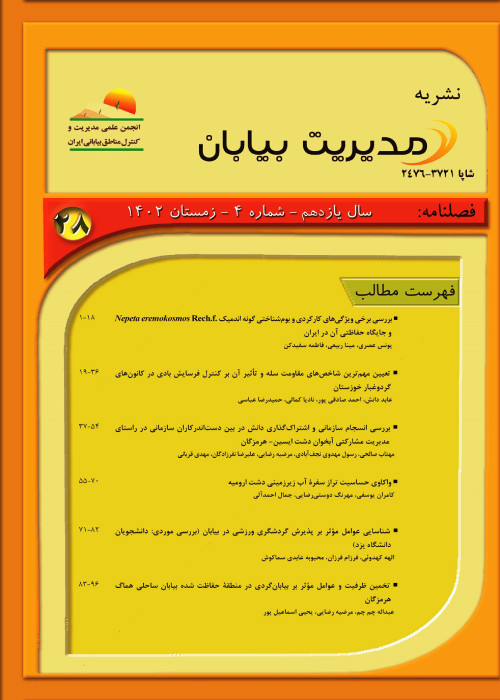Investigating the Effect of The Habitat and Type of Extracted Organ on The Phytochemical Compounds of Caper (Capparis Spinosa L.) As A Medicinal and Pasture Plant
With the increasing world's population, the need for food and medicine, and their continuous supply, are essential for mankind. Medicinal plants are one of the important factors for human life, as they can be used both as food and medicine. The ancients had a long history of using medicinal plants, and they used their many properties extensively. The scientific name for Caper plant is Capparis spinosa L. Due to its resistance to environmental stress and its ability to act as a protector against soil destruction, this valuable medicinal plant is suitable for growing in arid and desert areas. Commercial cultivation of this plant is very valuable because it is rich in bioactive compounds. This plant's compounds can be extremely useful and effective in protecting humans from various diseases or enhancing the treatment of diseases. This study aimed to examine the total phenol and flavonoid composition, antioxidant activity, and extraction efficacy of various parts of this plant in two desert locations in Yazd and Isfahan to select the best cultivation region from these two sites for expanding cultivation. To determine the most effective compounds and the optimal extraction method, various organs of the plant were examined separately in this research. The best extraction efficiency can be achieved by growing the plant in the region and harvesting the desired organ, and the extracted materials can be used to prevent and treat diseases.
The caper plant was collected from desert sites in Yazd and Isfahan in different parts, which included leaves, stems, buds, flowers, fruits, and roots. Plants were collected from four different locations on the site, and finally, the plants from four different locations were combined. After the botany expert's approval, extraction was done from different parts of the plant with hydroalcoholic solvent (80% ethanol) by the Soxhlet method. In this research, different experiments of total phenol, total flavonoid, antioxidant content, and extraction efficiency were performed using standard methods. Different dilutions of extract and standard material were made for all experiments. Folin Ciocalto's reagent was used to measure the total phenol, and it was reported according to the Gallic Acid standard per gram dry weight of the plant. Different tests like ABTS, DPPH, CUPRAC, and FRAP were employed to measure the plant's antioxidant content. The standard for milligrams of Trolox per gram of dried plant weight was used to calculate all of them. The number of flavonoids was measured based on the Aluminium Chloride colorimetry method and was expressed in the standard form of milligrams of Quercetin per gram of weight of the dried plant. To determine the extraction efficiency, the weight of the powder extract obtained from the extraction of different organs was calculated with a scale, and then the ratio of the weight of the powder extract of the weight of dried plant was reported as extraction method efficiency. For each of the experiments, 3 repetitions were performed. A two-way analysis of variance was utilized to examine the data's normality, and finally, IBM SPSS Statistics 26 software was utilized to analyse them.
The findings demonstrated that phenolic and flavonoid compounds were abundant in various parts of the caper plant from both locations. The leaves demonstrated a higher concentration of phenolic and flavonol compounds, with 48.611 mgGA/gDW and 19.842 mgQE/gDW, respectively. The antioxidant activity of roots was the highest among all parts of the plant. The Yazd site's caper plants were found to have a higher total phenolic and flavonoid content, with 35.572 mgGA/gDW and 14.14.164 mgQE/gDW, when compared to the other regions. The highest antioxidant activity was found in the fruit and root of the caper plant using the DPPH method. The ABTS method's measurement of antioxidant activity resulted in the same results and indicated that fruits had the highest activity. A positive correlation was observed between the amount of phenol and flavonoids. Furthermore, the Yazd site had a higher extraction efficiency than the Isfahan site, measuring 16.754%. The best region between two desert sites is also the best organ for extraction, as per the results of the current investigation. These results can be utilized to cultivate caper plants that contain more effective substances. These findings emphasize the status of the Caper plant as a rich source of secondary metabolites and show its potential as a potent healing agent with highly beneficial compounds, the site of Yazd is a suitable site for the cultivation of this plant. By cultivating this plant, in addition to helping to reduce desertification and prevent soil erosion, it is possible to have a source of secondary metabolites, especially phenol and flavonoid compounds, and use them in many medicinal applications.
- حق عضویت دریافتی صرف حمایت از نشریات عضو و نگهداری، تکمیل و توسعه مگیران میشود.
- پرداخت حق اشتراک و دانلود مقالات اجازه بازنشر آن در سایر رسانههای چاپی و دیجیتال را به کاربر نمیدهد.




